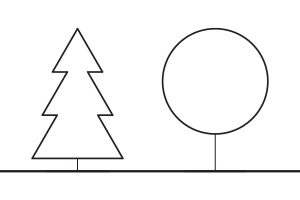Lumber for rough carpentry is referred to by its nominal dimension size, such as 2 x 4. This 2 x 4 refers to 2” x 4” for the dimension the wood is milled to, however, after drying the wood shrinks as moisture evaporates and its dimension becomes less. A milled 2 x 4 piece of wood, ends up being 1-1/2” x 3-1/2”. Note that all construction grade wood dries at consistent rates regardless of size, so 1” depth will always reduce to 3/4″.
Note that there are technical trade differences/definitions in the usage of the words: lumber, boards, timber. However, in our experience, these differences are so nuanced that unless speaking directly with a mill or defining them in your specifications, they can get easily interchanged. To learn more about those; visit our hardwood and softwood page here.
Nominal vs Actual
| Nominal | Actual (inch) | Actual (mm) |
| 1 x 1 | 3/4 x 3/4 | 19.05 x 19.05 |
| 1 x 2 | 3/4 x 1-1/2 | 19.05 x 38.10 |
| 1 x 3 | 3/4 x 2-1/2 | 19.05 x 63.50 |
| 1 x 4 | 3/4 x 3-1/2 | 19.05 x 88.90 |
| 1 x 5 | 3/4 x 4-1/2 | 19.05 x 114.30 |
| 1 x 6 | 3/4 x 5-1/2 | 19.05 x 139.70 |
| 2 x 2 | 1-1/2 x 1-1/2 | 38.10 x 38.10 |
| 2 x 3 | 1-1/2 x 2-1/2 | 38.10 x 63.50 |
| 2 x 4 | 1-1/2 x 3-1/2 | 38.10 x 88.90 |
| 2 x 6 | 1-1/2 x 5-1/2 | 38.10 x 139.70 |
| 2 x 8 | 1-1/2 x 7-1/4 | 38.10 x 184.15 |
| 2 x 10 | 1-1/2 x 9-1/4 | 38.10 x 234.95 |
| 2 x 12 | 1-1/2 x 11-1/4 | 38.10 x 285.75 |
| 4 x 4 | 3-1/2 x 3-1/2 | 88.90 x 88.90 |
Nominal: Common shorthand and pre-dried size for a piece of wood (2 x 4)
Actual: Actual ‘real’ dimension of the piece of wood (1-1/2” x 3-1/2”)
Not all wood sizes are available in all species of wood. You can of course custom order ‘anything’… but if specifying or construction using ‘off the shelf’ materials, you may have trouble finding certain sizes, especially at home improvement stores (Menards, Home Depot, Lowes)
- Example: 2 x 5 is not a standard dimension carried. Therefore, you’d have to move up to 2 x 6 or down to a 2 x 4. Moving down allows you to build back up to a 2 x 5, or order the custom size at a premium price.
Moisture Content
All wood has moisture in it, and wood will swell with water and shrink without it. Moisture content is the weight of water in wood as a fraction of the weight of oven-dry wood. The moisture affects the wood’s strength, shrinkage, weight, and withdrawal resistance of nails.
Design
Without allowing the wood to move in the detailing, it can cause issues if compounded over multiple members and time, especially in overly humid or wet environments. It’s also important to consider air movement around wood to allow proper drying for the piece. If the wood is laminated, it may not allow proper drying and the moist wood over time will disintegrate.
Fiber Saturation Point
Water will swell the wood up to a point, where then the wood fibers cannot accept any more moisture. This point is known as the Fiber Saturation Point. Above this point (30%+) the wood is dimensionally stable, but below this point (-30%), the wood shrinks.
- This point averages about 30% moisture in all woods.
- DRY LUMBER: Wood with less than 19% moisture.
- KILN DRIED: Less than 15% moisture.
Board Foot
A common unit of measurement and used for estimation is the ‘board foot’. This represents in theory the amount of wood to fill up 144 Sq Inches. (1” x 12” x 12”).
Calculation
To calculate, there are 2 main ways, depending on whether you are using feet or inches for your board length.
- Width (inches) x Depth (inches) x Length (feet) / 12” = Board feet.
- Width (inches) x Depth (inches) x Length (inches) / 144” = Board feet
There can be a bit of confusion with this calculation, because different vendors may use slightly different definitions based on what exactly you are purchasing.
Example: If calculating wholesale, it’s typical to use nominal sizes for the Width and Depth, while the Length of the board is off the actual number.
- For a 2×4 at 10 feet long, will be (2” x 4” x 10’ / 12) = 6.67 Board Feet
- “Actual” volume measurement of this wood (1-½” x 3-½” x 10’ / 12) = 4.38 Board Feet
Therefore, make sure to always double check with a vendor on how they are calculating their board feet and pricing. These calculations can change whether the wood is rough carpentry or finish, along with the species of wood.






Leave a Reply
You must be logged in to post a comment.